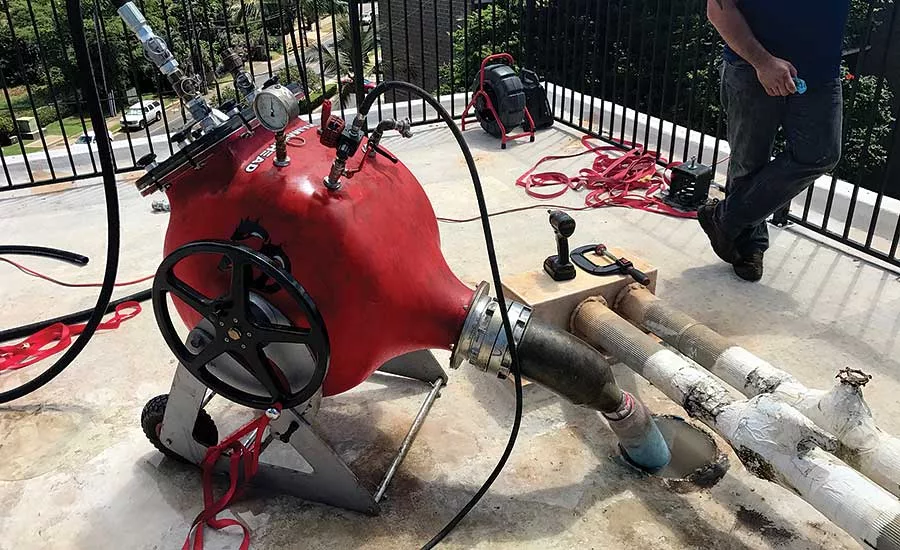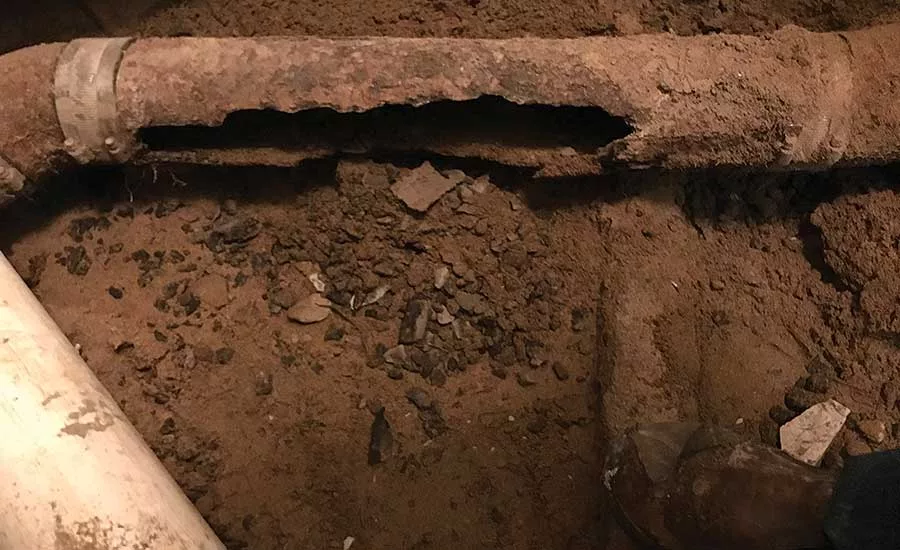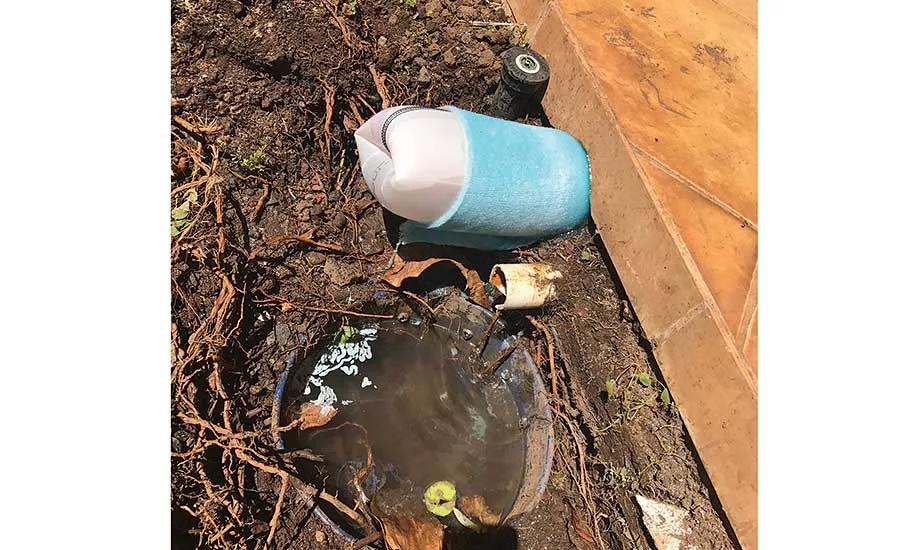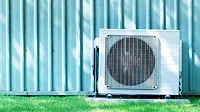Hawaii contractor helps refurbish sewer lines
It is becoming an increasingly urgent concern throughout the Aloha State.

Quality CIPP installations performed by qualified CIPP contractors give owners a simple, neat and cost-effective solution. Credentials of quality contractors include having been trained to install a manufacturer’s products to its OEM specifications and ready access to 24/7 product support from that manufacturer. Photo courtesy of HammerHead Trenchless, a Charles Machine Works Co.

Hawaii’s saltwater climate takes a toll on the cast-iron pipe originally chosen for storm and wastewater drainage system installations. The corrosion-resistant cured-in-place-pipe (CIPP) solution is saving project owners millions of dollars over open-cut pipe replacement methods. Photo courtesy of HammerHead Trenchless, a Charles Machine Works Co.

Wet-out liner (liner whose pores are uniformly impregnated with resin) spooled into a sealed drum “inverts” into the existing pipe as the drum is charged with air pressure. Hot water in a calibration tube inverted within the new liner activates the resin to begin the cure. Photo courtesy of HammerHead Trenchless, a Charles Machine Works Co.
Although the cast-iron pipe originally chosen for storm and wastewater drainage systems in Hawaii is more resistant to corrosion in a saltwater climate than other materials, the salinity of the air and groundwater still cut short its useful life. It is becoming an increasingly urgent concern throughout the Aloha State.
Initially skeptical
L&K Plumbing, a full-service plumbing company based in Maui, the Valley Isle, has been having great success using the cured-in-place pipe (CIPP) technique to renovate cast-iron pipes rather than open cut demolition and restoration.
L&K founder Ikaika Delmundo says the technique is saving his customers “millions” now, though he initially put little faith in lining pipes as a trustworthy alternative for his Maui customers.
“I thought, ‘They’re looking for a shortcut but there isn’t one — the only way you fix the problem is to replace the pipe,’” Delmundo says.
The first CIPP job Delmundo saw firsthand served only to further his skepticism. Delmundo, who has 18 years of experience and an island-wide reputation for making sure every job is done right, was the go-to plumber when a CIPP installation company needed to sub-contract help to handle the traditional plumbing services required as part of an extensive CIPP renovation of a resort’s corroded cast-iron storm runoff and sewer lines.
After several installation failures, the installer was removed from the project only partway through the job. What Delmundo saw made him shake his head.
“I saw liner sagging six feet into the pipe,” Delmundo says. “It hardened like that, leaving a really thick seam. It proved to me that lining isn’t an answer. We don’t want it here.”
Another chance
The ornate walls and exquisite granite floors of Maui’s luxury resorts, however, quickly render any pipe-replacement job that involves demolition and restoration cost-prohibitive. The island needed an alternative to pipe replacement, and again Delmundo’s reputation preceded him when a second CIPP installer needed an expert plumber for a condo pipe replacement job.
This time, the mainland contractor was a highly skilled installer working closely with the CIPP product line’s manufacturer, HammerHead Trenchless of Lake Mills, Wisconsin. On this job Delmundo met HammerHead CIPP installation expert Cory Steckmann, who was providing onsite consultation for the job. The experience almost instantly converted him.
“It was just so unfortunate that the first CIPP installation Ikaika saw was that other project,” Steckmann says. “There’s no reason it should have failed.”
Steckmann says all leading manufacturers make a variety of high-quality CIPP liners and resins precision-engineered for a given site’s conditions. Using the right products for the job — to the manufacturer’s specifications — is a proven pipe solution for a variety of pipe materials and a wide array of job requirements.
Delmundo was not an easy sell, however, and asked to see the lining work its magic for himself. On this job, the crew was able to expose a 12-foot section where the CIPP inversion would pass in open ground. As Steckmann inverted wet-out liner through the pipe, Delmundo watched its progress at the hole.
“It was amazing,” he says. “You could see the liner passing through it. Where the pipe was cracked and separated, resin squeezed into them, sealing up the cracks.”
Every pore of the polyester felt CIPP liners is uniformly saturated with resin during the wet-out process. The liners then bond completely to the existing pipe as it inverts, forming a new composite pipe. The cured plastic liner is ideal for Maui’s harsh salt-water climate, sealing it from further corrosion, and the finished installation is waranteed to last a minimum of 50 years.
“When we cammed the pipe, it was just so perfectly smooth inside, right through fixtures,” Delmundo says.
A CIPP lining’s smooth surface also improves flow rates, resists blockages and prevents groundwater and root intrusion, Steckmann points out.
Delmundo says the technique’s value to property owners was immediately obvious to him.
“CIPP can save them millions of dollars, easily. You’re not tearing out their walls and floors,” and resident and visitor routines continue undisturbed throughout the installation.
Successful installations
For three years now, L&K has been one of Hawaii’s leading CIPP installers.
“It’s an island. Word of what we can do gets around from one customer to the next,” Delmundo says.
As for training, Delmundo says he was “taught by the best — Cory Steckmann,” who also helped Delmundo train Colton Martin, a young apprentice who was hired in November 2017.
“Colton’s a natural,” Delmundo says, adding that proper training is critical in every aspect of the plumbing trade. “I want Colton to have a well-rounded plumbing background. Lining’s just one service we perform.”
With Delmundo as his mentor, Martin learned the ins and outs of CIPP operations on an on-going, long-term CIPP project for a full-service luxury resort, whose residential units offer renters 1,500- and 1,900-square-foot living accommodations. The project as a whole involves sewer lines, storm drains, manhole-to-manhole pipe lining, lining of vent stacks and its wall-embedded rooftop runoff system.
“The first guys had started on a variety of the CIPP work here. On the roof, there were 12 runoff pipes to do. They only did two before they stopped. We cleaned those up and shot those, and then we did the other 10,” Delmundo says.
The work for this resort is done in stages, each according to a prioritized list worked out between L&K and the project owner. Warranty work from the first installation is at the top of the list, with emergency work done first as it comes up.
“For instance, we had a week of rain that revealed cracks in some of the lines. So, we did those right away,” Delmundo explains. As warranty work is completed, L&K tends to other CIPP installations remaining throughout the rest of the resort.
Work on the resort’s vertical rooftop drainage pipes consisted of lining 12 drainage pipes. Each 4-inch pipe descended 80 to 90 feet vertically through its walls for the first 60 to 70 feet before transitioning to 6-inch horizontal pipe about 8 feet beneath the buildings. Here L&K used 4-inch HH Flex-Liner and 6-inch calibration tubes. The HH Flex-Liner was chosen for its ability to transition to the 6-inch horizontal pipe. L&K used a HammerHead summer resin mix for longer working time in the warm Hawaiian climate.
The two drains that had improperly installed liners in them were not as difficult to clean as Delmundo had anticipated.
“We just used our Maxi-Miller and chains on it. Those liners came out in chips and flakes. We sent a camera down to make sure they were clean and then just did a normal installation,” he says.
These were “open bag” installations, Delmundo says. The crew inverted the wet-out liner and tubes together in a single shot working from the roof. The liner was left open on both ends. Only the calibration tube was closed to hold the hot water used to activate the thermosetting resin.
Once inverted and filled, L&K’s boiler kept the water warm and circulating in the tube. The crew allowed three to four hours cure time. When they returned to the pipe, they first verified the cure was complete and then pulled the calibration tube, smoothing the lining ends and opening any reinstatements using their Maxi-Miller rotary tool and a grinding panel head. Then they video-inspected the installation. They could perform two installations a day using this method.
Several of the runs were complicated by 90- and 45-degree joints. One of the 8-inch laterals extended 220 feet at 8 feet deep. It was shot 110 feet each way from both ends, leaving a seamless transition in the middle.
One of the verticals in particular concerned Delmundo. It was a 90-foot run with two long-turn 90-degree bends followed by two 45-degree bends and then another 90-degree bend on the bottom. While Delmundo was offsite, Martin shot it on his own.
“Colton just knew that he could do it, and so he did it, right through all those fittings, no problem,” Delmundo says.
“Oh, yes!” Steckmann says, laughing. “I wasn’t there but I do remember getting a call on that one. [He said Martin] is quickly becoming a top-notch CIPP installer in his own right.”
L&K is currently a five-man operation but may be growing.
“We’re very busy,” Delmundo said. “CIPP is becoming an increasingly large portion of our business.”
Looking for a reprint of this article?
From high-res PDFs to custom plaques, order your copy today!





